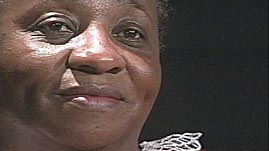Lola Hendricks grew up in Birmingham, Alabama in the 1940s, then one of
the most segregated cities in the South. In the 1950's, Birmingham's
segregation ordinances banned African Americans from using city parks,
playgrounds, and golf courses; they were refused service at lunch
counters and were relegated to using "colored" water fountains
and bathrooms; they were forced to sit in the back of buses, even after
bus segregation was ruled unconstitutional by the Supreme Court; and
black children were prohibited from attending the same schools as white
children, even after the Supreme Court ruled that segregated schools
were unconstitutional.
A corrupt police department enforced the status quo by condoning police
brutality and refusing to investigate or punish acts of violence against
African Americans, such as the Ku Klux Klan's castration of an innocent
young black man named Judge Aaron in the early 1950s. (Aaron was saved
when Klan members, unaware of its antiseptic nature, poured turpentine
on his wounds.) Discrimination and racial violence isolated Birmingham's
black community, but it also strengthened the resolve of African
Americans to fight segregation.
In 1956, Alabama state officials outlawed the National Association for
the Advancement of Colored People (NAACP) for its role in the Montgomery
bus boycott. In response, Hendricks joined civil rights leader Fred
Shuttlesworth and other African Americans to form the Alabama Christian
Movement for Human Rights (ACMHR). The ACMHR organized demonstrations
and boycotts to protest segregation in Birmingham's schools and
businesses. The group also challenged segregation laws by openly defying
them and by filing lawsuits to overturn them. In 1961, the ACMHR won a
lawsuit to integrate Birmingham's 67 city parks. Public Safety
Commissioner Eugene "Bull" Connor retaliated by closing the parks.
Hendricks used her position at a large black-owned insurance agency to
make connections in the business community and raise money for the Civil
Rights movement. Hendricks later worked for the Southern Christian
Leadership Conference (SCLC), headed by Martin Luther King Jr., where
she served as secretary to the SCLC's executive director, Wyatt T. Walker.
In 1963, Hendricks' daughter, Audrey, was one of the youngest children
to march in the Children's Crusade in Birmingham, in which approximately
2,000 school children were arrested and jailed. The campaign for civil
rights in Birmingham and the ensuing racial violence focused national
attention on segregation and racial tension, setting the stage for the
1963 March on Washington, and for President John F. Kennedy to draft
civil rights legislation, which. ultimately became the Civil Rights Act
of 1964.

 Loading Standards
Loading Standards